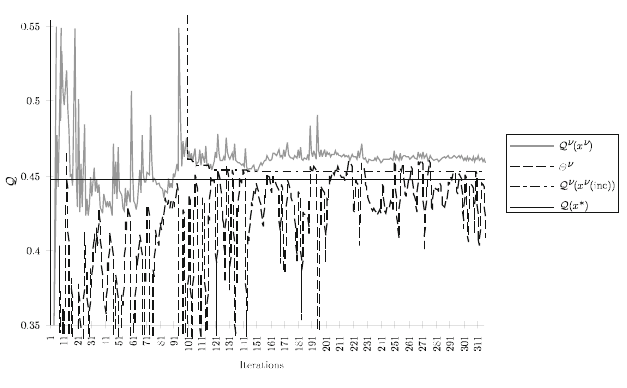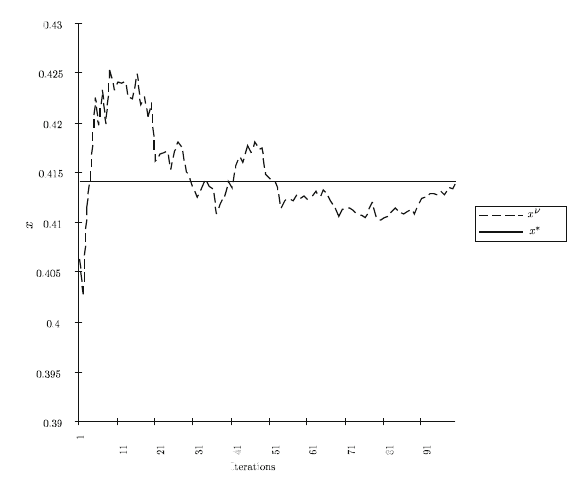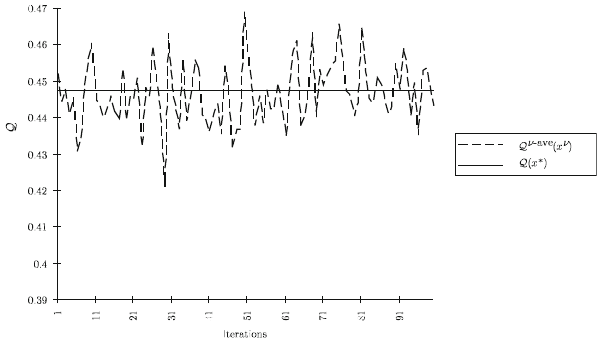Birge J.R., Louveaux F. Introduction to Stochastic Programming
Подождите немного. Документ загружается.


394 9 Monte Carlo Methods
Fig. 1 Solutions for crude Monte Carlo and importance sampling.
Fig. 2 Objective values for crude Monte Carlo and importance sampling.
9.2 Stochastic Decomposition 395
The results in Figures 1 and 2 indicate that sampled cuts in the L -shaped method
can produce fairly accurate results but that convergence to optimal values may re-
quire large numbers of samples for each cut even for small problems and may yield
inaccurate results with independent samples for each cut due to the bias issue. This
difficulty is particularly an issue if initial cuts are generated with small numbers
of samples since these may be particularly inaccurate and limit convergence unless
they are removed in favor of more accurate cuts. A procedure to avoid this problem
is gradually to remove initial cuts as the algorithm progresses. This is the intent of
the approach in the next section.
Exercises
1. Show how to sample from the density g
x
(
ξ
) as the sum of the absolute values
|x −
ξ
i
|, i = 1,2 for Example 1.
2. Consider Example 1 in Section 5.1 with ξ uniformly distributed on [1,5] .Ap-
ply the crude Monte Carlo L -shaped method to this problem for 100 iterations
with 100 samples per cut. What would the result be with importance sampling
in this case?
3. Apply both the crude Monte Carlo and importance sampling approaches to
Example 1 with both x
1
and x
2
decision variables. First, use 100 samples for
each cut for 100 iterations and then compare to results with an increase to 500
samples per cut.
9.2 Stochastic Decomposition
An alternative approach to using cuts produced with multiple samples in the L -
shaped method is to use cuts constructed from small but increasing numbers of
samples. This approach from Higle and Sen [1991b] generates many cuts with small
numbers of additional samples on each cut and adjusts these cuts to drop away as the
algorithm continues processing. The method is called stochastic decomposition.We
will give a basic development here and refer to Higle and Sen [1996] for more de-
tails. For simplicity, we assume complete recourse, a known (probability one) lower
bound on Q(x,
ξ
) (e.g., 0 ), and a bounded set of dual solutions to the recourse
problem (3.1.1). We also assume that K
1
and
Ξ
are compact.
With these assumptions, the basic stochastic decomposition method generates
iterates, x
k
, and observations,
ξ
k
. We can state the basic stochastic decomposition
method in the following way.
Basic Stochastic Decomposition Method
Step 1.Set
ν
= 0,
ξ
0
=
¯
ξ
,andlet x
1
solve

396 9 Monte Carlo Methods
min
Ax=b,x≥0
{c
T
x + Q(x,
ξ
0
)} . (2.1)
Step 2.Let
ν
=
ν
+1andlet
ξ
ν
be an independent sample generated from ξ .Find
Q
ν
(x
ν
)=
1
ν
∑
ν
s=1
Q(x
ν
,
ξ
s
)=
1
ν
∑
ν
s=1
(
π
ν
s
)
T
(
ξ
s
−Tx
ν
) .Let E
ν
=
1
ν
∑
ν
s=1
(
π
ν
s
)
T
T
and e
ν
=
1
ν
∑
ν
s=1
(
π
ν
s
)
T
ξ
s
.
Step 3. Update all previous cuts by E
s
←
ν
−1
ν
E
s
and e
s
←
ν
−1
ν
e
s
for s = 1,...,
ν
−
1.
Step 4.Solvethe L -shaped master problem as in (1.8) to obtain x
ν
+1
.GotoStep2.
This method differs slightly from the basic method in Higle and Sen [1991b] in
our assuming
π
ν
s
to be optimal dual solutions in each iteration. Higle and Sen allow
a restricted set of dual optima that may decrease the solution effort (with perhaps
fewer effective cuts).
The main convergence result is contained in the following theorem.
Theorem 1. Assuming complete recourse, Q(x,
ξ
) ≥ 0 , bounded dual solutions to
(3.1.1), K
1
and
Ξ
compact, there exists a subsequence, {x
ν
j
}, of the iterates of the
basic stochastic decomposition method such that every limit point of {x
ν
j
} solves
the recourse problem (3.1.1) with probability one.
Proof: We follow the proof of Theorem 4 in Higle and Sen [1991b]. We use their
Theorem 3 (Exercise 1), which gives the existence of a subsequence of {x
ν
} such
that
lim
ν
→∞
θ
ν
− max
l=1,...,
ν
(e
l
ν
−1
−E
l
ν
−1
x
ν
)=0 . (2.2)
Suppose {x
ν
j
} is a subsequence of the subsequence achieving (2.2) such that
lim
j
x
ν
j
= ˆx where A ˆx = b , x ≥ 0 . This occurs for some subsequence by com-
pactness. From x
∗
optimal,
c
T
x
∗
+ Q(x
∗
) ≤c
T
ˆx + Q( ˆx) . (2.3)
Note that because Q(x,
ξ
) ≥ 0forall
ξ
∈
Ξ
and Q(x,
ξ
i
) ≥
π
T
(h
i
−Tx) for any
π
T
W ≤ q and any sample
ξ
i
,forany 1≤ s ≤
ν
,
ν
∑
i=1
Q(x,
ξ
i
) ≥
s
∑
i=1
π
T
(h
i
−Tx) , (2.4)
where
π
is any feasible multiplier in the recourse problem for
ξ
i
.From(2.4), it
follows that
1
ν
∑
ν
i=1
Q(x,
ξ
i
) ≥ e
ν
l
−E
ν
l
x for all l and
ν
,where E
ν
l
and e
ν
l
are
the components of Cut l on Iteration
ν
. Therefore,

9.2 Stochastic Decomposition 397
c
T
x + max
l=1,...,
ν
(e
ν
l
−E
ν
l
x) ≤ c
T
x +
1
ν
ν
∑
i=1
Q(x,
ξ
i
) . (2.5)
As
ν
increases,
1
ν
∑
i=1
ν
Q(x,
ξ
i
) → Q(x) ,so
limsup
ν
[c
T
x
∗
+ max
l=1,...,
ν
(e
ν
l
−E
ν
l
x
∗
)] ≤ c
T
x
∗
+ Q(x
∗
) , (2.6)
with probability one. We can also show that (Exercise 2)
lim
j
c
T
x
ν
j
+ max
l=1,...,
ν
(e
ν
l
−E
ν
l
x
ν
j
)=c
T
ˆx + Q( ˆx) , (2.7)
with probability one. Thus, (2.6), (2.7), and the fact that x
ν
j
minimizes c
T
x +
max
l=1,...,
ν
−1
(e
ν
−1
l
−E
ν
−1
l
x) over feasible x yield
c
T
x
∗
+ Q(x
∗
) ≤ c
T
ˆx + Q( ˆx)
≤ limsup
ν
[c
T
x
∗
+ max
l=1,...,
ν
(e
ν
l
−E
ν
l
x
∗
)]
≤ c
T
x
∗
+ Q(x
∗
) , (2.8)
which proves the result.
One difficulty in this basic method is that convergence to an optimum may only
occur on a subsequence. To remedy this, Higle and Sen suggest retaining an in-
cumbent solution that changes whenever the objective function falls below the best
known value so far. The incumbent is updated each time a sufficient decrease in the
ν
th iteration objective value is obtained. They also show that the sequence of in-
cumbents contains a subsequence with optimal limit points, and then show how this
subsequence can be identified. Various approaches may be used for practical stop-
ping conditions, such as the statistical verification tests for optimality conditions in
Higle and Sen [1991a].
Example 1 (continued)
We again consider Example 1 from Section 8.2. The basic stochastic decomposition
method results appear in Figures 3 and 4. In Figure 3, both the basic result x
ν
and the incumbent solution, x
ν
(incumbent), which is adjusted whenever a solution
after the first 100 iterations improves the previous best estimate by 1%. Figure 3
also gives the optimal solution, x
∗
. The total number of iterations yields about
50,000 subproblem solutions, which is approximately equal to the total number of
iterations in Figures 1 and 2. Note that the raw solutions x
ν
oscillate rapidly, while
the incumbent solutions settle close to x
∗
quite quickly after their initiation at
ν
=
100 .

398 9 Monte Carlo Methods
The objective value estimates,
θ
ν
, Q
ν
,and Q
ν
(x
ν
(inc)) for the incumbent,
and the optimal objective value, Q(x
∗
) , appear in Figure 4. Note that the
θ
ν
values
from the master problem have wide oscillations. The Q
ν
(x
ν
) values have lower but
significant variation. The incumbent objective values, however, show low variation
that begins to approach the optimum.
Fig. 3 Solutions for the stochastic decomposition method.
Exercises
1. Prove Theorem 1. Show first that eventually the objective value of (1.8)for x
ν
n
at iteration
ν
n
is the same as the objective value of (1.8)for x
ν
n
at iteration
ν
n−1
.
2. Prove that there exists a subsequence of iterates {x
ν
} in the basic stochastic
decomposition method with the assumptions so that (2.2) holds.
3. Suppose a subsequence of iterates x
ν
j
→ ˆx in the basic stochastic decomposi-
tion method. Prove that (2.7) holds.
4. Apply the basic stochastic decomposition method to Example 1 in Section 5.1
with ξ uniformly distributed on [1,5] . Record the sequence of iterations until
10 consecutive iterations are within 1% of the optimal objective value.

9.3 Stochastic Quasi-Gradient Methods 399
Fig. 4 Objective values for the stochastic decomposition method.
9.3 Stochastic Quasi-Gradient Methods
Stochastic quasi-gradient methods represent one of the first computational devel-
opments in stochastic programming. They apply to a broad class of problems and
represent extensions of stochastic approximation methods (see, e.g., Dupaˇc [1965]
and Kushner [1971]). Our treatment will be brief because the emphasis in this book
is on methods that exploit the structure of deterministic equivalent or approximation
problems. Ermoliev [1988] provides a more complete survey of these methods.
Stochastic quasi-gradient methods (SQG) apply to a general mathematical pro-
gram of the form:
min
x∈X⊂ℜ
n
g
0
(x)
s. t. g
i
(x) ≤ 0 , i = 1,...,m , (3.1)
where we assume that each g
i
is convex. We suppose that an initial point, x
0
∈ X ,
is given. The method generates a sequence of points, {x
ν
}, that converges to an
optimal solution of (3.1).
Given a history at time
ν
, (x
0
,...,x
ν
) , the method selects function estimates,
η
i
(
ν
) , and subgradient estimates, β
i
(
ν
) , such that
E[η
i
(
ν
) | (x
0
,...,x
ν
)] = g
i
(x
ν
)+a
i
(
ν
) (3.2)
and
E[β
i
(
ν
) | (x
0
,...,x
ν
)] + b
i
(
ν
) ⊂
∂
g
i
(x
ν
) , (3.3)
400 9 Monte Carlo Methods
where a
i
(
ν
) , b
i
(
ν
) may depend on (x
0
,...,x
ν
) but must satisfy
a
i
(
ν
) → 0andb
i
(
ν
)→0 . (3.4)
When b
i
(
ν
) = 0, β
i
(
ν
) is called a stochastic quasi-gradient.Otherwise, β
i
(
ν
) is
a stochastic subgradient.
We first consider the method when all constraints are deterministic and repre-
sented in X. Thus, Problem 3.1 becomes
min
x∈X⊂ℜ
n
g
0
(x) . (3.5)
The method requires a projection onto X represented by
∏
X
(y)=argmin
x
{x −y
2
| x ∈ X} .
In the basic method, a sequence of step sizes {
ρ
ν
} is given. The stochastic quasi-
gradient method defines a stochastic sequence of iterates, { x
ν
},by
x
ν
+1
=
∏
X
[x
ν
−
ρ
ν
β
0
(
ν
)] , (3.6)
where we interpret the projection as operating separately on each element
ω
∈
Ω
,
so that x
ν
+1
(
ω
)=
∏
X
[(x
ν
(
ω
) −
ρ
ν
β
0
(
ω
)(
ν
))] .
To place all these results into the two-stage recourse problem as in (1.1.2), let
X = {x |Ax = b, x ≥0} , g
0
(x)=
g
0
(x,ξ)P(dξ) where
g
0
(x,ξ)=inf
y
{q
T
y |W y = h−Tx, y ≥ 0} .
Thus, we can use β
i
0
(x) such that β
i
0
(x)
T
(h
i
− T
i
x)=g
0
(x,ξ
i
) ,
W
T
β
i
0
(x) ≤ q
i
for a sample ξ
i
composed of the components, h
i
, T
i
,and q
i
.
The stochastic quasi-gradient method takes a step in this direction and then projects
back onto X . In the following example and the exercises, we explore the use of this
approach.
For these examples, we use an estimate of the objective value by taking a moving
average of the last 500 samples, Q
ν
−ave
(x
ν
)=
∑
499
i=0
Q(x
ν
−i
,
ξ
ν
−i
)/500 . Changes
in this estimate (or the lack thereof) can be used to evaluate the convergence of
stochastic quasi-gradient methods. Gaivoronski [1988] discusses various practical
approaches in this regard.
Example 1 (continued)
We consider the same example and apply the stochastic quasi-gradient method. On
each step
ν
, a random sample
ξ
ν
is taken with
β
0
(
ν
) ∈
∂
Q(x
ν
,
ξ
ν
) .For X = {x |
0 ≤x ≤1}, the projection operation yields x
ν
+1
= min(1,max(x
ν
+
ρ
ν
β
0
(
ν
),0)) .

9.3 Stochastic Quasi-Gradient Methods 401
Figures 5 and 6 show these iterations for solutions x
ν
and objective estimates,
Q
ν
−ave
for every multiple of 500 iterations up to 50,000 so that total numbers of
recourse problem solutions are the same as in Figures 1 to 4.
Fig. 5 Solutions for the stochastic quasi-gradient method.
Note that the iterations in Figure 5 appear to approach x
∗
much more quickly
than the results in Figures 1 to 4. They also seem to show lower variances in the
objective estimates in Figure 6, although these results are not converging to zero
variance because the sample length 500 is not changing. To achieve convergence
or greater confidence in a solution, the number of samples in the estimate must
increase.
While the results in Figures 5 and 6 indicate that stochastic quasi-gradient meth-
ods may be more effective than the decomposition methods, we should note that
this example is quite low in dimension. For higher dimensions, the results are often
quite different. In general, stochastic quasi-gradient methods exhibit similar behav-
ior to subgradient optimization methods that often have slow convergenceproperties
in higher dimensions. They are, nonetheless, easy to implement and can give good
results, especially in small problems.
In the rest of this section, we discuss the theory behind the stochastic quasi-
gradient method convergence. The exercises consider examples for using SQG.
The basic method in (3.6) traces back to the unconstrained methods of Robbins-
Monro [1951]. The main device in demonstrating convergence of {x
ν
} to a point

402 9 Monte Carlo Methods
Fig. 6 Objective values for the stochastic quasi-gradient method.
in X
∗
is the use of a stochastic quasi-Feyer sequence (see Ermoliev [1969]), a
sequence of random vectors, {w
ν
},definedin (
Ω
,
Σ
,P) such that for a set W ⊂
ℜ
n
,E[w
0
2
] < +∞ ,andany w ∈W ,
E{w −w
ν
+1
2
| w
0
,...,w
ν
}≤w −w
ν
2
+ γ
ν
,
ν
= 0,1,... ,
γ
ν
≥ 0 ,
∞
∑
ν
=0
E[γ
ν
] < +∞ . (3.7)
The following result shown in Ermoliev [1976] is the basis for the convergence
results.
Theorem 2. If {w
ν
} is a stochastic quasi-Feyer sequence for a set W , then
(a) {w −w
ν
+1
2
} converges with probability one for any w ∈W , and E[w −
w
ν
2
] < c < +∞ ;
(b) the set of limit points of {w
ν
(
ω
)} is nonempty for almost all
ω
∈
Ω
;
(c) if ¯w
1
(
ω
) and ¯w
2
(
ω
) are two distinct limit points of {w
ν
(
ω
)} such that
¯w
1
(
ω
) ∈ W, ¯w
2
(
ω
) ∈ W,then W⊂ H , a hyperplane such that
η
= {w |
α
T
w =
α
0
}, ¯w
1
(
ω
) −
∏
η
( ¯w
1
(
ω
)) = ¯w
2
(
ω
) −
∏
η
( ¯w
2
(
ω
)),where
∏
η
denotes projections onto
η
.
With this result, we can obtain the most basic convergence result, given below
without proof.
Theorem 3. Given the following:

9.3 Stochastic Quasi-Gradient Methods 403
(a) g
0
(x) is convex and continuous,
(b) X is a convex compact set,
(c) the parameters,
ρ
ν
, and γ
0
(
ν
)= inf
x
∗
∈X
∗
β
0
(
ν
)
T
(x
ν
−x
∗
) , satisfy with proba-
bility one,
ρ
ν
> 0 ,
∞
∑
ν
=0
ρ
ν
=+∞ ,
∞
∑
ν
=0
E[
ρ
ν
| γ
0
(
ν
) | +(
ρ
ν
)
2
β
0
(
ν
)
2
] < ∞ , (3.8)
then, with probability one, for any ¯x(
ω
)=lim
ν
i
x
ν
i
(
ω
) , ¯x(
ω
) ∈ X
∗
.
The general method can be amplified in a variety of ways. Condition (c) can
be relaxed to remove the finiteness of
∞
∑
ν
=0
ρ
2
ν
when
γ
(
ν
)=0forall
ν
,butthe
convergence is for
∑
ν
x
ν
ρ
ν
∑
ν
ρ
ν
(see Uriasiev [1988]).
Two important aspects of stochastic quasi-gradient implementations are the de-
terminations of step sizes and stopping rules. Various adaptive step sizes are consid-
ered by Mirzoachmedov and Uriasiev [1983]. For stopping rules, we refer to Pflug
[1988], where details appear. The results describe the use of stopping times {
τ
ε
},
to yield uniform asymptotic level
α
confidence regions,definedby
lim
ε
→0
inf
x
0
P{x
τ
ε
−x
∗
≤
ε
}≥1 −
α
. (3.9)
Deterministic step size rules do not, unfortunately, produce such uniform confidence
intervals. Instead, Pflug shows that an oscillation test stopping rule does obtain such
confidence regions. In this rule, a test is performed to check whether the iterates are
oscillating without objective improvement. The key is building consistent estimates
of the objective Hessian at x
∗
and the covariance matrix of objective errors. For
other issues concerning implementation, we refer to Gaivoronski [1988].
The use of sample subgradients can also produce results for efficient computation
with some confidence level. Nesterov and Vial [2008] give one of these results for
a stochastic subgradient method in which the values of multiple algorithm paths are
combined to achieve efficient computation. Dyer,Kannan, and Stougie [2002] and
Shmoys and Swamy [2006] both use stochastic subgradients in a different way to
define regions of improvement over which the ellipsoid optimization method can be
applied. Combining this approach and a search step can for many stochastic linear
programs in fact find a solution within
ε
of optimal with effort on the order of
1
ε
and a factor depending on the problem input size (Shmoys and Swamy [2006]).
